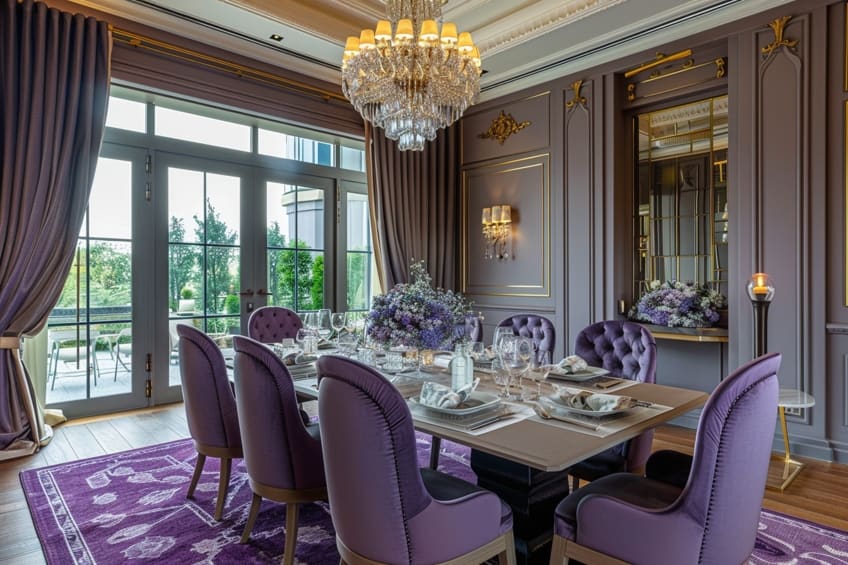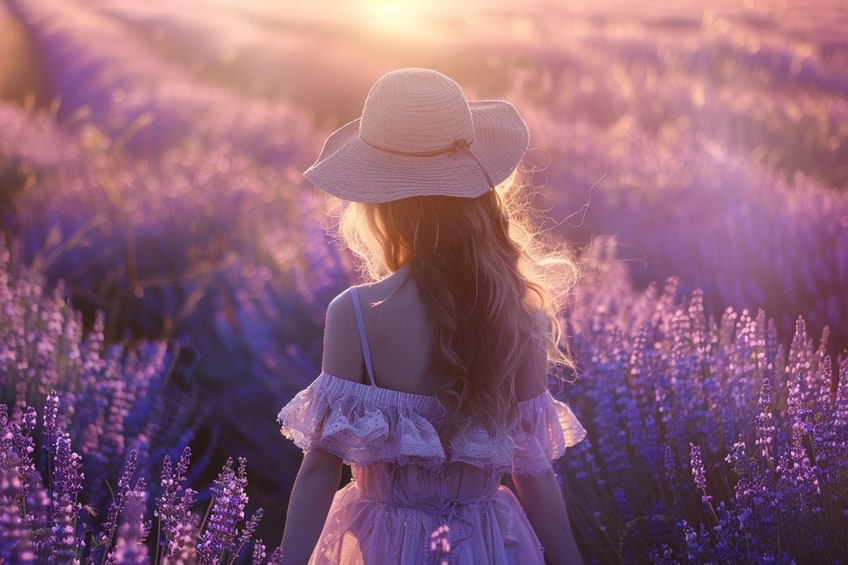Meaning of the Color Lavender – Purple Profundity
Lavender, with its delicate and dreamy hue, dances between the realms of purple and lilac, captivating our senses with its enchanting charm. As a color theory enthusiast, diving into the meaning of lavender is akin to exploring a garden of emotions and symbolism. From its calming influence on our minds to its associations with luxury and spirituality, lavender is a color that whispers stories of serenity and sophistication. Join me on this colorful journey as we unravel the mysteries and meanings behind the beautiful shade of lavender.
Key Takeaways
- Lavender is a tranquil hue often associated with calmness, meditation, and elegance.
- Symbolically, it represents femininity, creativity, and has historical ties to luxury.
- Its applications range from design and fashion to aromatherapy and healing practices.
Historical Significance
| Shade | Hex Code | CMYK Color Code (%) | RGB Color Code | Color |
| Lavender | #E6E6FA | 8, 8, 0, 4 | 230, 230, 250 |
The color lavender is a distinctive shade that stands on its own despite often being associated with both purple and pink tones. This subtle yet elegant color is known for its calming and tranquil qualities, which makes it a preferred choice for creating a space that encourages relaxation and meditation. Its uniqueness is further highlighted by its association with the lavender plant, which is renowned for its soothing fragrance and has been extensively used in aromatherapy practices.

As a symbol, lavender holds various meanings. In historical contexts, it has been connected to royalty and luxury due to its resemblance to purple, yet it evokes a gentler, more approachable aura. In contemporary times, the color is often tied to femininity, grace, and an air of mystique, influencing its application in fashion and design. Lavender’s versatility also extends to its psychological impact, where it is thought to promote self-reflection and spirituality, and enhance creativity.
Lavender in Ancient Cultures
Historically, the name lavender is believed to stem from the Latin verb lavare, meaning “to wash.” Romans used lavender for its fragrance and antiseptic qualities in bathing routines, recognizing its natural scent and benefits for hygiene.
The Romans popularized lavender across their empire, bringing it into homes and public areas for a sense of freshness and cleanliness.
Lavender Throughout History
Throughout history, lavender has maintained symbolic significance within the Christian faith, especially during periods like Lent and Easter. Its use during Lent is linked to its purifying and calming properties. In biblical texts, lavender was often used for anointing and healing, associating the plant and its color with calmness, healing, and purity. Lavender’s ongoing historical use underscores its lasting cultural and spiritual resonance across time periods and traditions.

The Meaning of the Lavender Color
Lavender is often associated with qualities of purity and devotion, with certain shades conveying a sense of luxury or elegance. Below, the associations of lavender are split into positive and negative connotations to provide a nuanced understanding of this hue.
Positive Associations
Lavender holds several positive meanings, including:
- Femininity: It represents qualities traditionally tied to women, such as grace and elegance.
- Serenity: The color is linked to calmness and stress relief, fostering a tranquil environment.
- Inspiration: It is thought to stimulate creativity and the imagination.

Negative Associations
Despite its many positive aspects, lavender carries a few negative connotations as well:
- Lack of urgency: In some contexts, the color can be seen as indicating hesitancy or a lack of seriousness.
- Frivolity: Occasionally, lavender might be perceived as frivolous or not commanding, potentially undermining its perceived value in more serious applications.
Personality Traits Associated With Lavender
The color lavender is deeply connected with certain personality characteristics, reflecting how individuals who favor this hue may perceive the world and themselves.
- Calmness: Lavender is typically linked to a calming disposition. Those who resonate with lavender may have a tranquil presence, often bringing a sense of peace to their surroundings.
- Creativity: It mirrors imaginative thinking; those inclined towards this color might exhibit a flair for creativity and often think outside conventional boundaries.
- Sensitivity: The gentle nature of lavender can indicate a sensitive and empathetic personality, with a keen awareness of others’ feelings.
- Romanticism: An affinity for lavender is sometimes aligned with a romantic and idealistic outlook, where individuals may prioritize harmony in their relationships.
- Nonconformity: This hue may represent a nonconformist streak, suggesting that those who are drawn to lavender value individuality and tend to steer clear of the mainstream.

The personality profile that associates with the color lavender thus presents a nuanced blend of tranquility, imaginative richness, and introspective depth. These traits reflect an underlying ethos of balance and an appreciation for beauty in its more subdued and gentle forms.
The Color Lavender in Design and Fashion
Lavender has made a significant impact in the worlds of design and fashion, known for its elegant, gentle beauty, and array of delightful shades. It’s a color that conveys sophistication and femininity, widely utilized for its tranquil and delicate appeal.
Fashion and Style
Lavender is a staple in fashion that embodies both elegance and flexibility. Designers often choose this hue for its ability to lend an air of femininity and grace to their garments. In style, it presents itself in various shades, from pale lilac to deep lavender, offering a spectrum for every season and occasion.
- Spring and summer fashion: Lighter shades of lavender are typically used in spring and summer collections to evoke a fresh, airy feel, perfect for daytime dresses and casual wear.
- Evening wear: Darker shades imbue a sense of sophistication, commonly featured in formal gowns and cocktail attire, enhancing the beauty of the fabric with a subtle yet captivating hue.

Design and Decor
In home decor, lavender is valued for its aesthetic and emotional appeal. It’s often incorporated into spaces requiring a tranquil atmosphere, from bedrooms to bathrooms, because the color’s calming effect promotes relaxation and a sense of peace.
- Wall colors and accents: Designers may paint walls with lavender or use it for accent pieces, balancing the space with a cool and soothing ambiance.
- Fabrics and textiles: A variety of home furnishings—throw pillows, curtains, and bedding—frequently don lavender shades, complementing both contemporary and traditional designs with their gentle charm.
Implications of the Lavender Color
Lavender, with its hex code #e6e6fa, embodies a delicate blend of purple and white, resulting in a pastel hue that carries significant implications in color psychology, symbolism, and cultural contexts.

Psychological Implications
In color psychology, lavender is associated with calmness and tranquility. It is believed to possess soothing properties that can assist in relaxation, making it a preferred shade in places requiring a peaceful ambiance like spas and salons.
Moreover, this color’s link to twilight often evokes a sense of reflective peace and the transition from the wakefulness of day to the restfulness of evening.
Emotional Associations
Emotionally, lavender strikes a balance between warm pink and cool blue, embodying the compassion of the former and the calmness of the latter. It is associated with grace and elegance, and in some instances, it can symbolize love at first sight. Lavender is also connected to healing and can be found in environments designed to foster a nurturing and supportive atmosphere.

Cultural Significance
By presenting a sense of order and conveying an uplifting, optimistic essence, the color lavender occupies a special place in design, culture, and individual perception, encapsulating a myriad of meanings from the spiritual to the regal.
- Royalty and religion: Historically, the deeper shades of purple were indicative of royalty and wealth. Lavender retains elements of this legacy and has also held religious significance, as mentioned in ancient texts for its role in anointing and devotion.
- Symbolism: Lavender’s symbolism extends to include creativity and femininity due to its gentle appearance. Cultural interpretations vary, but devotion, spirituality, and the search for higher understanding are frequent themes related to this hue.
Aromatherapy and Healing
The lavender color is inextricably linked with its fragrant counterpart, which is extensively used in aromatherapy for healing and relaxation. The scent of lavender essential oil is particularly valued for its soothing properties and medicinal benefits.

Lavender in Aromatherapy
Lavender Essential Oil: As a prime component in aromatherapy, lavender essential oil is renowned for inducing relaxation and reducing stress. It releases a pleasant fragrance that is used in various forms including:
- Scented candles: Ideal for creating a tranquil ambiance.
- Diffusers: To disperse the soothing aroma throughout a room.
Mental and emotional benefits include:
- Stress relief: Inhaling the lavender scent can significantly decrease stress levels.
- Improved sleep quality: Utilized in sleep aids, the scent aids in relaxation before sleep.
Medicinal Uses of Lavender
Antiseptic Properties: Lavender has potent antiseptic abilities, making it effective in treating minor cuts, burns, and insect bites. It helps to prevent infection and promotes faster healing. The herb’s medicinal benefits are not limited to aromatherapy; its use in topical applications underscores its versatility in promoting overall well-being.
- Pain relief: Application of lavender oil on sore muscles can result in pain reduction.
- Skin care: Lavender oil is often found in skin treatments for its anti-inflammatory and soothing effects.

The color lavender is not just a pigment on the palette; it’s a symphony of emotions and a tapestry of meanings woven into our cultural and personal narratives. Whether it’s the soothing scent of lavender fields or the regal allure of a lavender-hued gown, this color has a way of resonating with our deepest desires for tranquility and elegance. So, the next time you encounter a splash of lavender, let it remind you of the beauty in simplicity, the harmony in subtlety, and the magic in every hue that colors our world. Embrace the lavender moments in life, for they are the whispers of peace and grace in our colorful existence.
Frequently Asked Questions
How Does the Color Lavender Relate to One’s Personality Traits?
Lavender is often associated with individuals who possess a calm and serene demeanor. It may indicate a personality that values tranquility and has a thoughtful, reflective nature.
What Does Lavender Represent in Romantic Contexts?
In romantic settings, the color lavender symbolizes enchantment and love at first sight. It carries a gentle energy and is sometimes connected to tender affection and understanding between partners.
Can the Color Lavender Have Spiritual Implications?
Spiritually, lavender is linked to higher consciousness and spiritual awakening. It’s considered to help with meditation and represents purity, devotion, and peace.
Isabella studied at the University of Cape Town in South Africa and graduated with a Bachelor of Arts majoring in English Literature & Language and Psychology. Throughout her undergraduate years, she took Art History as an additional subject and absolutely loved it. Building on from her art history knowledge that began in high school, art has always been a particular area of fascination for her. From learning about artworks previously unknown to her, or sharpening her existing understanding of specific works, the ability to continue learning within this interesting sphere excites her greatly.
Her focal points of interest in art history encompass profiling specific artists and art movements, as it is these areas where she is able to really dig deep into the rich narrative of the art world. Additionally, she particularly enjoys exploring the different artistic styles of the 20th century, as well as the important impact that female artists have had on the development of art history.
Learn more about Isabella Meyer and the Art in Context Team.
Cite this Article
Isabella, Meyer, “Meaning of the Color Lavender – Purple Profundity.” Art in Context. April 9, 2024. URL: https://artincontext.org/meaning-of-the-color-lavender/
Meyer, I. (2024, 9 April). Meaning of the Color Lavender – Purple Profundity. Art in Context. https://artincontext.org/meaning-of-the-color-lavender/
Meyer, Isabella. “Meaning of the Color Lavender – Purple Profundity.” Art in Context, April 9, 2024. https://artincontext.org/meaning-of-the-color-lavender/.









